When it comes to choosing a set of hubs, it's not
that easy since there's a few to choose from. Warn and MileMarker
are two brands that come to mind of many fellow off-roaders. Unlike
the winches, both brands of hubs operate in the same fashion. So
the big question is, Which brand is better? Well, we'll try to give
you the facts and you can make the decision yourself.
Before we begin, let's start by saying we have the best of the
best. Our front axle that the hubs rest in is a GM 1 ton Dana 60.
The Warn hubs are the premium manual set. The MileMarker hubs are
the Supreme Stainless manual models. Both hubs are all-metal
construction and plastic is not used anywhere on the hubs. Plastic
models are usually cheaper but for strength and durability we
wanted the metal. Both Warn and MM make some hub variations that
are not all completely metal in the 1/2 ton Dana 44 models. In the
Dana 60 application, MM only has one offering - the Stainless Steel
449SS. Warn has 2 different models available for the Dana 60, and
the less expensive model does have some plastic components. Testing
the strength of the hubs is a little difficult since we don’t
have a special machine to measure the torque placed on each hub so
we’ll have to test both hubs the old fashion way; on the
trails. Our power comes from a 454, which is always being upgraded
for more power and torque so there will be some tremendous force
placed on these. Through the year(s), we’ll have both brands
installed and try to torture both brands. If anything happens to
either brand, this article WILL be updated with the broken results.
Warn is a common name when it comes to the 4x world. Warn makes
winches, axle shafts, lift kits, shocks and other miscellaneous
off-road gear. When we first got the Warn premiums, they looked to
be durable. The external hub body is constructed of aluminum, which
is chrome plated. The inner body is also made of aluminum which
doesn't sound like it would be that strong but the body is thicker
with longer clutch-ring spline teeth and body spline area resulting
in better load handling. Inside the cap assembly, wave spring
technology is used. Warn Premium Manual hubs feature a larger body
wall thickness to optimize clutch-ring strength. Rapid positive
engagement prevents ratcheting, dual dial seals lock out
contaminants. Warn premium hubs look to have brass center dials. In
the body, that's true but when looking closer at the dial, its not
really brass. The dial is actually pot metal. The 6 cap screws are
smaller than the MileMarker but they do have rubber o-rings to help
seal better. Care must be taken when tightening the cap screws
since they screw in aluminum and could easily strip the threads.
The dial takes a full turn (actually 7/8) which makes it easy to
engage/disengage the hubs. So far, the Warns have performed fine
for us but time will tell.
MileMarker is not new to the market. For over a decade, MileMarker
has been manufacturing and supplying parts for Chrysler, Rockwell
International & Dana Corporation. From the hydraulic winch
system the their selective all wheel drive system, MileMarker
designs and creates some great products for your off-road vehicle.
Besides locking hubs, MileMarker manufactures off-road accessories
such as winches, mounts, viscous couplings, air compressors,
transfer-case components, as well as manufactures many gears,
brackets and shafts for other companies. The hubs we got from
MileMarker are the Supreme Stainless models. The Supreme and Street
Master models feature a "full metal jacket" cap with stainless
steel exposed to the elements. These are made using a new process
of die-casting aluminum into a pre-made stainless jacket, it
provides lightweight, strength and corrosion resistance. We really
like the choice of metals Mile Marker puts in their hubs.
MileMarker uses a Ductile Iron Hub body which is good for strength.
The Ductile iron is the same metal you will find on 1 ton Dana 60
axles. The iron also helps prevent the 6 cap screws from stripping.
Another plus for the MileMarker is the cap screws are larger than
Warns. The center dial is stainless steel and looks to be stronger
than the dial on Warn. The dial takes 1/3 of a turn to lock, which
takes a little more effort than the Warns 1 full turn. Fortunately,
MileMarker included a handy dial handle, which makes it easier to
engage/disengage the hub. The only thing short we found on
MileMarker, is the ability to seal out water on deep-water
crossings. The center dial has a single seal where Warn has a dual
seal and there wasn’t any rubber o-rings on the cap bolts
like the warn hubs. Keep in mind, you should ALWAYS repack your hub
bearings going through any water crossing no matter which brand you
run. So far, MileMarker has performed fine.
When we first acquired our Dana 60 axle, it already came with
MileMarker hubs. This axle (and hubs) had been through some serious
abuse. There was many parts that had to be replaced. We elected to
replace the hubs even though they still would have worked if they
were taken apart, cleaned and greased. The outside of the hubs had
seen better days but they were still functional. Now, if you talk
to some fellow off-road buddies, you will always get a mixed
opinion. Many times, whatever winch they’re running,
that’s the brand of hubs they prefer.
Installation (for either brand): First, the old hubs
have to be removed. This is accomplished by removing the six cap
screws. Next was use snap ring pliers to remove the snap ring. You
might have to use an old rag to remove some of the grease so you
can see the ring. The next step was to remove the large lock ring
that holds the body assembly in the wheel housing. This is a little
tricky, but if you have two small screw drivers, its not too bad.
After the large lock ring is removed, the body assembly can be
removed. We found the easiest way to do this was to thread two of
the screws in the body assembly across from each other and pull
with equal pressure. Once the old assembly is out, we took a rag
and cleaned out some of the old grease and put a thin coat of new
grease inside the wheel housing.
NOTE: DO NOT PACK AN EXCESSIVE AMOUNT OF GREASE IN THE WHEEL HOUSING BECAUSE THIS CAN CAUSE DAMAGE TO THE HUBS.
Once the wheel housing was prepared for the new hubs, the install
process is done all in reverse. When you reach the large lock ring,
make sure to install the new ring provided in the kit. You may need
to re-use the snap ring. We inspected ours and it was in perfect
condition. If any wear is found, do not hesitate to replace it with
a new ring. The final step is to install the new metal cap assembly
and the six new Allen head socket screws. Torque the screws to
proper torque per the install instructions and wipe off any excess
grease that may have got on the cap.

Mile Marker
Dept ORC
1450 S.W. 13th Court
Pompano Beach, FL 33069
(800) 886-8647
www.milemarker.com

Warn Industries, Inc.
Dept ORC
12900 S.E. Capps Road
Clackamas, Oregon 97015
(800) 543-9276
www.warn.com
|
Here's the
hubs with their bodies below. Notice Warn uses aluminum and
MileMarker uses iron. The Warn body is thicker.
Click picture for larger
image
|
|
MileMarker on
the left, Warn on the right. Both seem to install easy. The next
step on either one is to install the center and outer lock rings.
The lock rings hold them in place.
Click picture for larger
image
|
|
Left picture
shows both cap screws. Warns is a little smaller than MileMarker.
Right picture shows the o-rings that goes around the Warns screws.
MileMarker didn't come with o-rings.
Click picture for larger
image
|
|
MileMarkers
center dial was just a little harder to engage/disengage. To help
your fingers out, they sent this nifty handle which makes it
easier.
Click picture for larger
image
|
|
We always
thought that was a solid brass dial, but after taking the Warn hub
apart, we found it to be a different metal.
Click picture for larger
image
|
| Warn | MileMarker | |
| Advantages | Doubled sealed at the dial Screws use rubber o-rings Easier to engage (full turn) | Stainless dial Stainless cap Ductile iron body Larger cap screws |
| Disadvantages | Dial has lower grade metal Aluminum body Smaller cap screws Cap screws could strip in body if over tightened | Harder to engage (1/3 turn) No cap screw o-rings Single seal on dial |
|
Warn on the
left, MileMarker on the right. This shows the other side of the
dials. Warn has two seals on the dial where MileMarker has
one.
Click picture for larger
image
|
NOTE: DO NOT PACK AN EXCESSIVE AMOUNT OF GREASE IN THE WHEEL HOUSING BECAUSE THIS CAN CAUSE DAMAGE TO THE HUBS.
|
This is the
inner wheel hub with nothing installed yet. Be sure to clean out
the old grease and apply a thin coat of new grease.
Click picture for larger
image
|
Mile Marker
Dept ORC
1450 S.W. 13th Court
Pompano Beach, FL 33069
(800) 886-8647
www.milemarker.com
Warn Industries, Inc.
Dept ORC
12900 S.E. Capps Road
Clackamas, Oregon 97015
(800) 543-9276
www.warn.com
Questions or comments about this page should be
directed to
chevy@off-road.com
Back to Project Potent Rodent Back to the Chevy WebPages
chevy@off-road.com
Back to Project Potent Rodent Back to the Chevy WebPages
Follow @Off-Road

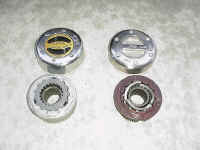
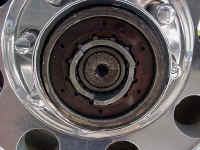
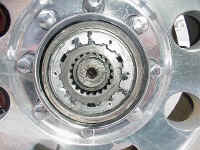
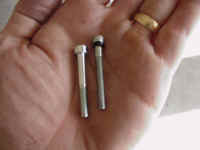
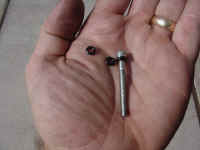
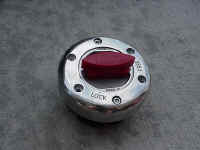
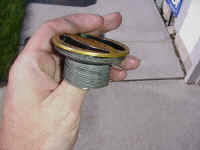
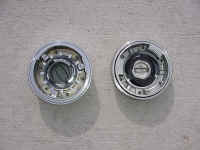
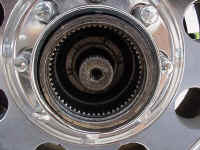
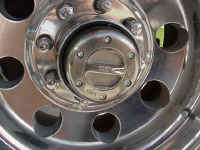

 Your Privacy Choices
Your Privacy Choices